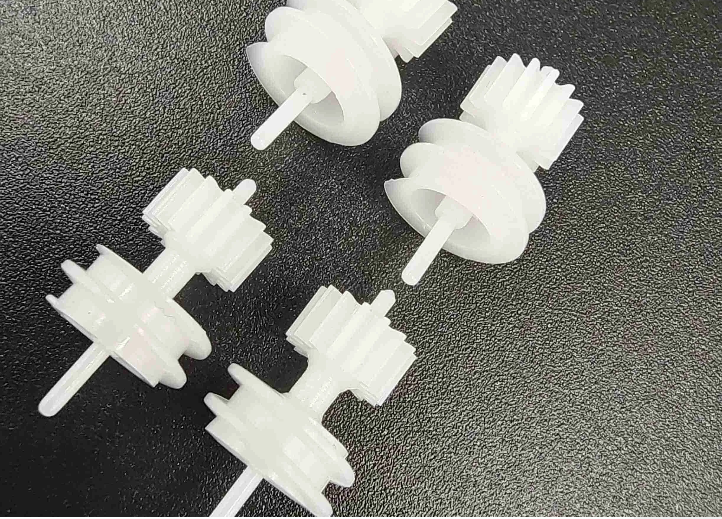Understanding Custom Injection Molded Products
Definition and Core Components
Custom injection molded products are precision-crafted items formed through the advanced injection molding process. This method injects molten polymer into a bespoke mold cavity under high pressure, defining a part with specific shape and size characteristics. Core components of this process include molds, injection machines, and material selection. These elements are crucial in achieving desired tolerances and form factors. Molds are specifically designed to house the liquid polymer until it cools and solidifies into the final product shape. The injection machines regulate pressure and temperature to ensure consistency and precision. Materials, ranging from polypropylene to polycarbonate, play a significant role in determining the finished product's strength and flexibility. This manufacturing process, renowned for its accuracy, is widely adopted across various industries requiring complex, tailor-made parts with high levels of uniformity.
Key Characteristics of Customization
Customization in injection molding offers bespoke design capabilities, tailored production runs, and adaptability to unique client specifications. This process allows for the precise creation of components that match specific requirements, whether for medical devices or automotive parts. The ability to tailor each aspect of production enhances innovation and competitiveness, significantly benefiting industries like pharmaceuticals, electronics, and automotive sectors. For example, the automotive industry demands uniquely designed components with tight tolerances, whereas the medical industry requires parts that conform to precise safety standards. Customizable injection molding ensures these sectors can achieve advanced product designs, fostering innovation and market differentiation. Consequently, businesses can stay ahead in rapidly evolving markets by employing injection molding to meet customer-specific needs, emphasizing the importance of customization in modern manufacturing and how it empowers industries to innovate.
The Injection Molding Process: Step-by-Step
Mold Design and Tooling
The foundation of the injection molding process is mold design, which utilizes Computer-Aided Design (CAD) technology to ensure dimensional precision. This initial phase is crucial because the mold dictates the final shape and tolerances of the product. Attention to detail and expert craftsmanship in creating these molds are imperative, as even minor inaccuracies can lead to defects in the final product. Tooling costs are a significant factor in this step, often requiring considerable upfront investment but ensuring that the molds can be used reliably and repeatedly. Precision in mold design ultimately determines the quality and customizability of the final product.
Material Selection and Melting
Choosing the right material is vital for ensuring the functionality and durability of the injection-molded products. Material selection should focus on properties that align with the end-use requirements, such as strength, flexibility, and temperature resistance. Once the material is chosen, the melting process begins. This involves heating the granular or pellet form of the plastic to achieve a uniform liquid state, enabling optimal flow and complete filling of the mold. Maintaining the appropriate temperature during melting is crucial as it impacts the consistency and quality of the final product.
Injection and Pressure Application
The heart of the injection molding process is the stage where molten material is introduced into the mold under high pressure. This injection phase is where precision surpasses simple filling; it influences the product's structural uniformity and consistency. High pressure ensures that every cavity within the mold is occupied, directly affecting the replication accuracy of the mold design. A complete and uniform fill allows products to maintain exact specifications and quality standards, reducing the likelihood of defects.
Cooling and Ejection
After the injection process, cooling is crucial to solidify the molten material into the desired form. The cooling phase allows the product to harden inside the mold, gradually taking on the detailed dimensions of the cavity. Factors such as material composition and mold design can influence cooling time. Once cooled, the ejection mechanism helps safely remove the solidified product from the mold. Proper timing during ejection is essential to prevent damage to the product, ensuring its readiness for subsequent finishing processes.
Quality Control and Finishing
Quality control is integral to the injection molding process, and it involves various measures to ensure products meet specified standards. Comprehensive inspections and tests are conducted to verify the dimensions and structural integrity of each item. Additionally, finishing processes like trimming and surface treatment are employed to refine product aesthetics and enhance functionality. These finishing touches generally involve polishing, painting, or coating the product, ensuring it meets high-quality benchmarks before reaching the consumer.
Materials Used in Custom Injection Molding
Thermoplastics vs. Thermosets
Choosing between thermoplastics and thermosets is a crucial decision in the injection molding process. Thermoplastics are polymers that become pliable when heated and solidify upon cooling. This reversible process makes them excellent for recycling and reshaping purposes. Thermosets, on the other hand, undergo a curing process that creates a permanent chemical bond; they cannot be remolded once set. The pros of thermoplastics include recyclability and versatility, whereas thermosets offer superior thermal and chemical resistance, ideal for high-heat applications. However, thermosets are generally less flexible in application due to their permanent nature.
Popular Resins (PP, ABS, Nylon)
In the realm of custom injection molding, common resins like Polypropylene (PP), Acrylonitrile Butadiene Styrene (ABS), and Nylon are extensively utilized due to their distinctive properties. Polypropylene (PP) stands out for its toughness and chemical resistance, making it suitable for food containers and automotive parts. Acrylonitrile Butadiene Styrene (ABS) is prized for its impact resistance and higher gloss finish, often employed in consumer electronics and automotive interiors. Nylon offers excellent tensile strength and thermal stability, making it ideal for applications that demand durability, such as gears and bearings.
Sustainability and Recycled Materials
Sustainability has become a cornerstone in today's manufacturing landscape, especially in plastic injection molding. Recycled materials are increasingly popular, helping reduce environmental impact. For example, recycling post-consumer plastics like PET bottles into secondary applications demonstrates an initiative towards sustainability. Prominent companies such as SABIC and BASF are leading the charge by integrating eco-friendly practices and materials in their processes, catering to the growing demand for sustainable manufacturing solutions while supporting the global effort to minimize plastic pollution.
Advantages of Custom Injection Molding
Precision and Repeatability
Custom injection molding excels in precision and repeatability, making it crucial for producing complex shapes accurately. This process ensures that each unit created adheres to strict specifications, reducing variability and enhancing product uniformity. For instance, manufacturers can achieve tolerances as tight as 0.005 inches in precision. Such precision is vital; a study published in the Journal of Manufacturing Processes suggests that high precision directly correlates with improved product quality and market competitiveness, reinforcing the industry's reliance on custom injection molding.
Cost Efficiency for Mass Production
Another advantage of custom injection molding is its cost efficiency, particularly for mass production. This method significantly reduces the per-unit cost, making it ideal for large production runs. When comparing costs, injection molding often proves more affordable than techniques like 3D printing and CNC machining for high-volume orders. According to a report by Plastics Technology, injection molding can reduce per-piece costs by approximately 20-40% compared to other methods, positioning it as a preferred choice for manufacturers aiming to balance quality and cost-effectiveness.
Design Flexibility
Custom injection molding offers unparalleled design flexibility, allowing manufacturers to create complex designs that would be challenging with other methods. This flexibility has paved the way for many successful product innovations. For example, a case study published in the Journal of Product Innovation Management highlights how custom injection molding enabled the creation of intricate medical device components that traditional methods could not support. This flexibility not only facilitates creativity but also opens doors to competitive market advantages by enabling unique design possibilities.
Overall, these advantages make custom injection molding a compelling choice for companies seeking to enhance precision, improve cost efficiency in mass production, and explore innovative design solutions.
Applications Across Industries
Automotive Components
Custom injection molding plays a vital role in producing various automotive components, enhancing performance and safety features. This manufacturing technique is utilized to create complex parts such as dashboards, bumpers, and interior panels, all integral to modern vehicles. The automotive sector benefits from the precision and consistency that custom injection molding provides, contributing to superior product quality and reliability. According to industry reports, the demand for injection molded automotive parts is increasing, driven by advancements in vehicle design and technology. This growth underscores the importance of injection molding in meeting the automotive sector's evolving needs.
Medical Device Manufacturing
The role of custom injection molding in manufacturing medical devices is crucial, particularly given the strict compliance requirements with regulatory standards. This method allows for the production of intricate devices that maintain high accuracy and quality, essential for patient safety and care. Medical equipment like diagnostic test kits and surgical instruments are commonly produced using injection molding due to its ability to offer tight tolerances and consistent results. The market for medical injection molding is projected to grow from USD 21.54 billion in 2023 to USD 36.43 billion by 2033, driven by a compound annual growth rate of 5.40%, reflecting its importance in healthcare innovation.
Consumer Electronics and Packaging
Custom injection molding is indispensable in the consumer electronics industry, providing lightweight yet durable components that cater to the sector's demands for miniaturization and functionality. Innovative appliances and gadgets increasingly incorporate injection-molded parts to enhance usability and aesthetic appeal. Furthermore, custom injection molding facilitates advancements in packaging, supporting the development of innovative designs that improve product presentation and preservation. The versatility offered by custom molds enables manufacturers to explore new trends in packaging, driving continual enhancements in product appeal and efficiency. This dual application in electronics and packaging highlights the adaptability and utility of injection molding across diverse consumer markets.
FAQ
What are custom injection molded products?
Custom injection molded products are precision-crafted items created by injecting molten polymer into a mold, allowing for specific shape and size characteristics according to desired specifications.
How is material selection important in injection molding?
Material selection is vital as it influences the strength, flexibility, and overall characteristics of the finished product, as well as its suitability for the intended application.
Why is custom injection molding cost-effective for mass production?
Custom injection molding is cost-effective because it lowers per-unit costs in large production runs compared to other manufacturing techniques, like 3D printing, due to its ability to produce consistent, high-quality parts efficiently.
What industries benefit from custom injection molding?
Industries such as automotive, medical device manufacturing, and consumer electronics greatly benefit from custom injection molding due to its precision, repeatability, and versatility in creating complex components.
How does custom injection molding contribute to sustainability?
Custom injection molding contributes to sustainability by using recyclable materials, reducing waste, and promoting the use of recycled content in manufacturing processes.
How Can Custom Injection Molding Help Reduce Production Costs?
Custom injection molding reduces production costs through efficiency in large-scale manufacturing, minimizing material waste, and ensuring consistent quality, which lowers the need for extensive quality checks and reworks.
Table of Contents
- Understanding Custom Injection Molded Products
- The Injection Molding Process: Step-by-Step
- Materials Used in Custom Injection Molding
- Advantages of Custom Injection Molding
- Applications Across Industries
-
FAQ
- What are custom injection molded products?
- How is material selection important in injection molding?
- Why is custom injection molding cost-effective for mass production?
- What industries benefit from custom injection molding?
- How does custom injection molding contribute to sustainability?
- How Can Custom Injection Molding Help Reduce Production Costs?

